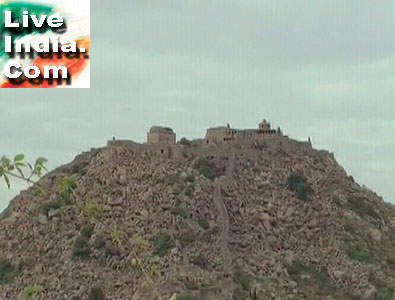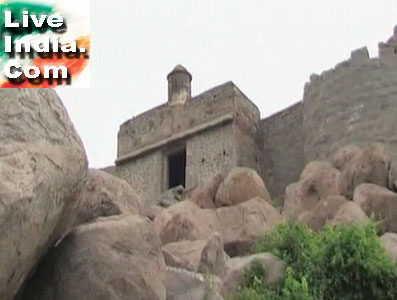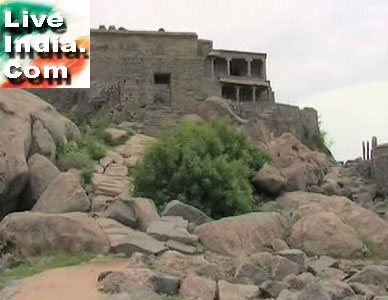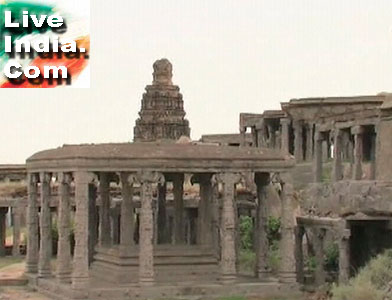| Krishnagiri fort
Gingee
The second important hillock
with an imposing citadel is known as Krishnagiri. It is also known as the
English Mountain, perhaps because the British residents occupied the fort
here, for some time. The Krishnagiri fort lies to the North of Tiruvannamalai
road. It is smaller in size and height compared to the Rajagiri fort. A
flight of steps of granite stones leads to its top. Another fort connected
with Rajagiri with a low rocky ridge is called Chandrayan Durg, Chandragiri
or St. George’s Mountain. The military and strategic value of this fort
has been relatively less, but it has some interesting buildings of later
period.
The third fort for some
reason is called Chakkiliya Durg or Chamar Tikri - meaning the fort of
the cobblers. It is not known why it had acquired such a name. Probably
the royal saddlers and military shoemakers had set up their workshops here,
as Gingee obviously was a military encampment. There is also a smaller
and less important fourth hill, the summit of which is also well fortified.
There is nothing much-left of Chandrayan Durg and Chakkilli Durg. Their
flanks are now completely covered with thorny shrubs and stone pieces.
However, they provide challenging trekking opportunity to the visitors
to Gingee.
Kapaleashwarar Temple
is located in Mylapore, Chennai, Tamil Nadu. Nayanmars sing hymns in this
temple. According to the Puranas, Shakthi worshipped Shiva, in the form
of the Peacock, which is why the name Mylai was given to the area that
developed around the temple, as 'Mayil' means Peacock in Tamil.The Pallavas
kings built the temple around 7CE. The pallava Nayanamars built this temple.
The presiding God of this
temple is a form of Shiva called Kapaleashwarar. The form of Shiva's wife
Parvati at this temple is called Karpagambal (from the Tamil for "goddess
of the wish-yielding tree"). Puranas have it that Lord Shiva was once telling
Lord Brahma, the Hindu god of creation, about the creation of the three
lokas but Lord Brahma did not agree with what Shiva said. Shiva got angry
and plucked out one of Brahma's four heads. Brahma begged for forgiveness
and was asked to perform penance at Mayilai (Mylapore) and then he asked
Lord Shiva to take the name of Kapaleashwarar as Lord Shiva (eswarar) was
wearing a necklace of skulls (kapala).
Any account of Gingee
should include a description of the rock-cut shrine of Singavaram, situated
about 3 kilometres (1.9 mi) from the fortress on a fifth hill called Singavaram
hill. It is a unique Vishnu temple. The deity of the shrine is Lord Ranganatha.
Lord Ranganatha is seen reclining on the serpent with his head turned to
a side. The expression on the face of the Lord is benign and charming.
The Gingee Ranganathan is ranked as one of the most beautiful Vishnu idols
anywhere. It is interesting to note that the place where the Singavaram
rock cut exists seems to have been originally a centre of Jain religion.
Several small and large Jain rock cuts and monoliths are found around the
temple. Gingee, hence, has emerged as an important surviving link of the
Tamil Jain tradition. Singavaram hill is visited both by the Hindu and
Jain pilgrims.
According to legend, it
is the original image of Ranganatha from the famous Srirangam temple, which
was taken away, from Srirangam and hidden in Gingee, for the sake of safety,
during the plundering of Srirangam at the hands of the Mohammedan invader
Malik Kafur. Lord Ranganatha is said to have been the tutelary Lord of
Gingee and the personal deity (Ishta devata) of Raja Desingh. There is
an underground tunnel that connects the Rajagiri fortress with the temple
and is supposed to have been used by Raja Desingh and his queen to visit
the temple unobserved. The existence of the tunnel itself is an indicator
of the authenticity of the image. The fact that the idol was hidden among
the rocks in a discarded Jain rock cut cave and was being worshipped unobserved
by the public is enough proof of the idol being a very ancient and important
one.
This tunnel is supposed
to actually connect two towns, the great and little Gingee, surrounded
by a wall. This wall is three 3 miles (4.8 km)in circumference and encloses
the two towns and five mountains of rugged rocks on the summit of which
were built five strong forts. The fifth mountain is Singavaram hill - in
addition to the four already mentioned forts, namely, Rajagiri, Krishnagiri,
Chandrayan Durg and Chakkili Durg. According to E. Scott Waring, Great
Gingee referred to the whole area including Singavaram, and little Gingee
was very likely to be Gingee proper, i.e., the area covered by four other
mountains. There were two separate towns known as Sheo Gingee (Siva Gingee)
and Vishnu Gingee (Vishnu Gingee - the latter being regarded by him as
a popular and flourishing town) surrounded by walls of considerable circumference.
The court of Sheo Gingee was formed into a citadel with basements and battlements
and consequently thinly inhabited; Vishnu Gingee was flourishing and the
resort of a large number of pilgrims, hence it can with great probability
be identified with Singavaram. A visit to Gingee would be incomplete without
a visit to Singavaram to see the reclining Vishnu and the Jain rock cuts. |









